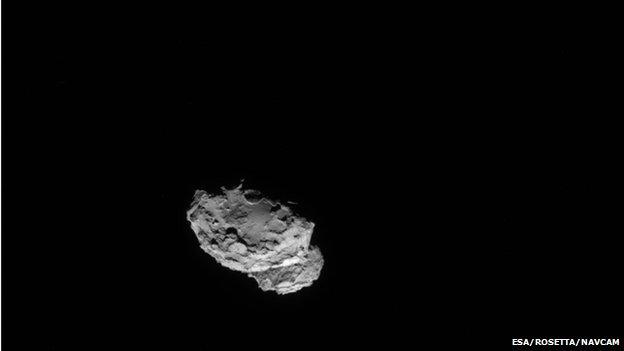Journey of understanding 'just beginning'
- Published

The comet on August 4th, from around 234km away
Europe's mission control here at Darmstadt in Germany cannot match the sheer exuberance of Nasa when it comes to celebrating triumphs.
Confirmation that Esa's Rosetta spacecraft had achieved its historic rendezvous with a comet was greeted with applause, wide grins and shouts of "yes, yes!", but none of the wild cheering we saw when Curiosity touched down on Mars two years ago.
But although Europe's style may be more muted, what's been achieved in the dark reaches of space far beyond Mars is remarkable by any standards.
You could almost feel the sense of relief in the corridors that, after managing a 10-year trek through space with extraordinary accuracy, and after investing more than one billion euros, all has gone so well.
The signal took nearly 23 minutes to reach us and, when it came, it was a dip in a line on a graph.
But this showed that the final burn to reach the comet had finished and this key moment was the trigger for a wave of pride rather than jubilation.
Getting a spacecraft to match the speed of a comet and effectively ride alongside it is a landmark in space exploration.
But the hard work starts now.
Just trying to comprehend the weird structure and shape of the comet is difficult enough, according to many here.
As one scientist put it, it's like driving along the motorway for hours and then turning off into a busy town where everything is confusing.
The next batches of pictures, taken from just 100km away, should provide some answers.
Traces of water

Rosetta spacecraft being launched from the Ariane-5 rocket in 2004
Another challenge is coping with the slight but irregular pulls of the comet's gravity - Rosetta is now just close enough to feel them.
The plan is to fly around the comet in a series of loops, and managing that task will take real care.
One of many puzzles is why the first readings of the surface temperature are not colder, an indicator that there might not be as much ice as expected.
On the other hand, one instrument has picked up traces of water flowing from the comet so we know there must be ice there.
The destination has been reached but the journey of understanding is only just starting.